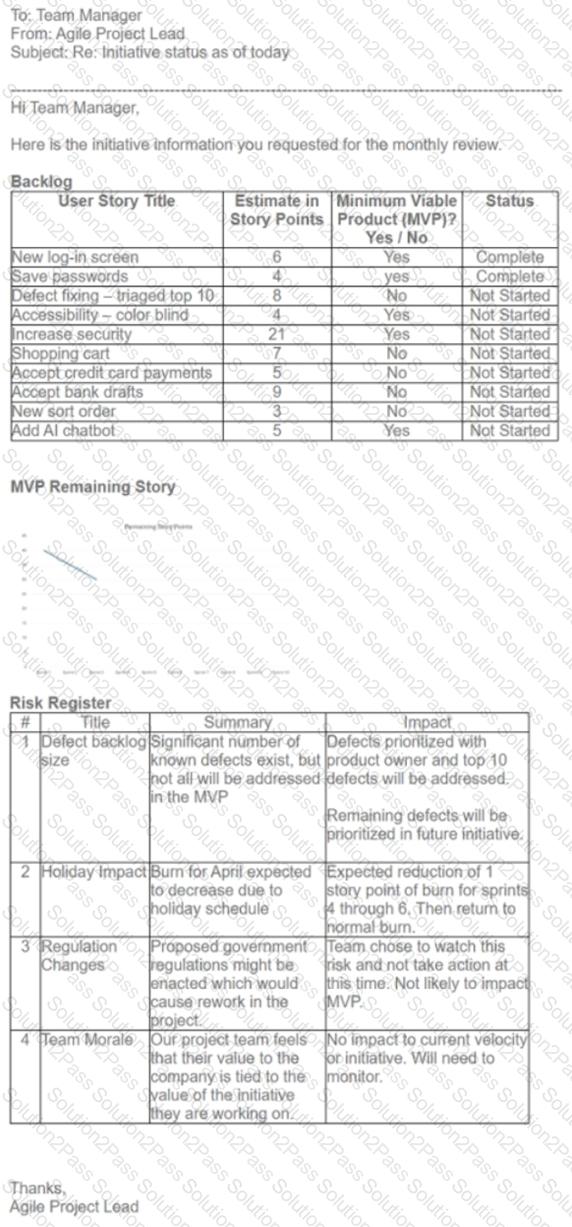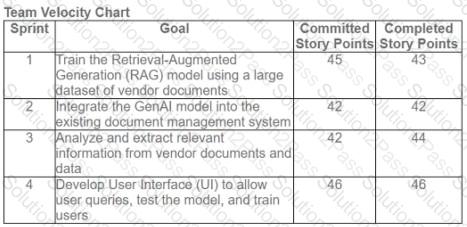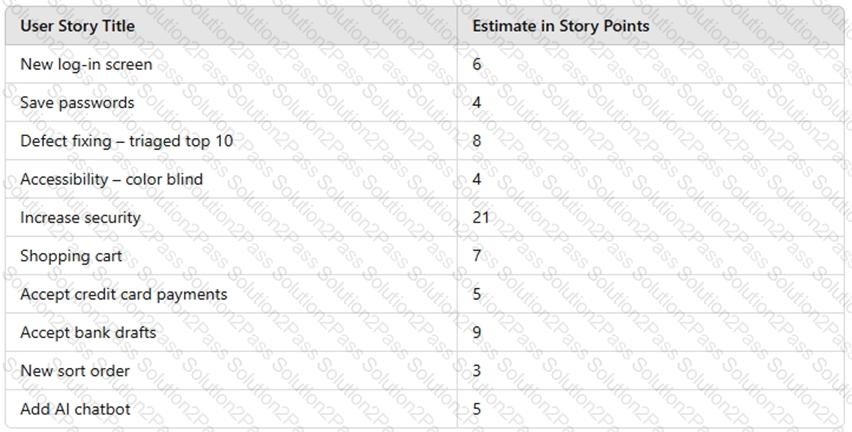PMI-ACP PMI Agile Certified Practitioner (PMI-ACP) Free Practice Exam Questions (2025 Updated)
Prepare effectively for your PMI PMI-ACP PMI Agile Certified Practitioner (PMI-ACP) certification with our extensive collection of free, high-quality practice questions. Each question is designed to mirror the actual exam format and objectives, complete with comprehensive answers and detailed explanations. Our materials are regularly updated for 2025, ensuring you have the most current resources to build confidence and succeed on your first attempt.
A customer has given a project team several requests for new features on a product. The customer is upset that the requests have been placed in the backlog and are not currently being worked on by the team.
What should the team do next?
Management decides to set up a new project to exploit an emergent market opportunity. Management suggests using an agile approach that is currently working for another project.
What should the agile leader do next?
What should the team do?
When a team member encounters an issue in an agile environment, what should they do?
An agile practitioner is in the process of refining requirements. The requirements keep changing based on with whom the agile practitioner speaks.
What should the agile practitioner do in this situation?
A company is planning to launch a new service to improve the customer checkout experience.
What should the project manager do to meet the objective of reducing time to market to gain a competitive advantage in the industry?
A company has decided to combine two similar products consisting of multiple teams into one product. Engaged customers want to know how the company is looking at re-organizing its teams.
What strategy should be employed to re-organize the teams?
What should the product owner do to resolve this?

A project team's manager is responsible for delivering a specific initiative for the organization. They are preparing for a monthly meeting where the manager will present on the current state of this initiative. The agile project lead sends the manager the following email with the current initiative status (see Exhibit A).
How many sprints will be needed to complete the entire backlog?
An agile coach advised a project manager to continuously improve their ability to support their team and remove any obstacles in the project's way. What role is the agile coach advising to the project manager to take on?
A product owner worked with the customer to define the success criteria for the launch of a new product in the manufacturing industry. The project team responsible for development is seeking guidance on what to develop first.
Which two actions should the product owner take? (Choose two.)
The team is in the middle of an iteration and there is an urgent request for a small change to be introduced to the committed scope. Unless this change is accepted, there is no value to the customers during this iteration.
What must the agile practitioner do?
After conducting the second retrospective with project stakeholders, the customer expresses frustration. The customer wants a more predictable roadmap for the delivery of features and functionalities.
How should the project manager respond to the customer?
There is a debate within the organization on whether projects need to be agile or waterfall. Some agile terms and principles are understood differently by the key stakeholders and this delays the decision-making process.
How should the scrum master proceed?
Midway through a sprint, the Scrum Master identifies that reassigning a certain task could help the team meet its sprint goals.
What should the Scrum Master do next?
What should the agile coach do in this situation?
The initial roadmap and release dates for an agile project were set based on data from similar projects and some expert opinions. Halfway through the project, however, the team’s estimates are different. Based on the team’s velocity, two more iterations were necessary to accomplish the initial scope.
How should the agile lead explain the difference to the project sponsor?
An agile project was underway for two months and delivered the expected value to the stakeholders. However, during a sprint review, a team member complained that the product owner constantly changes requirements and the member feels that this is blocking the team’s performance.
How can the scrum master handle this situation?

The team is considering committing to 44 story points for the upcoming sprint. Based on the
velocity chart, what advice should the scrum master offer the team?

 Normal sprint velocity: 5 story points per sprint
Normal sprint velocity: 5 story points per sprint Reduced velocity for sprints 4-6: 4 story points per sprint
Reduced velocity for sprints 4-6: 4 story points per sprint First 3 sprints: 5 points per sprint → 5 × 3 = 15 story points completed
First 3 sprints: 5 points per sprint → 5 × 3 = 15 story points completed Sprints 4-6: 4 points per sprint → 4 × 3 = 12 story points completed
Sprints 4-6: 4 points per sprint → 4 × 3 = 12 story points completed Remaining story points after sprint 6: 72 - (15 + 12) = 45 story points
Remaining story points after sprint 6: 72 - (15 + 12) = 45 story points Remaining sprints needed at normal velocity (5 story points per sprint): 45 ÷ 5 = 9 sprints
Remaining sprints needed at normal velocity (5 story points per sprint): 45 ÷ 5 = 9 sprints Sprints 1-6: Already planned.
Sprints 1-6: Already planned. Additional 9 sprints needed.
Additional 9 sprints needed.